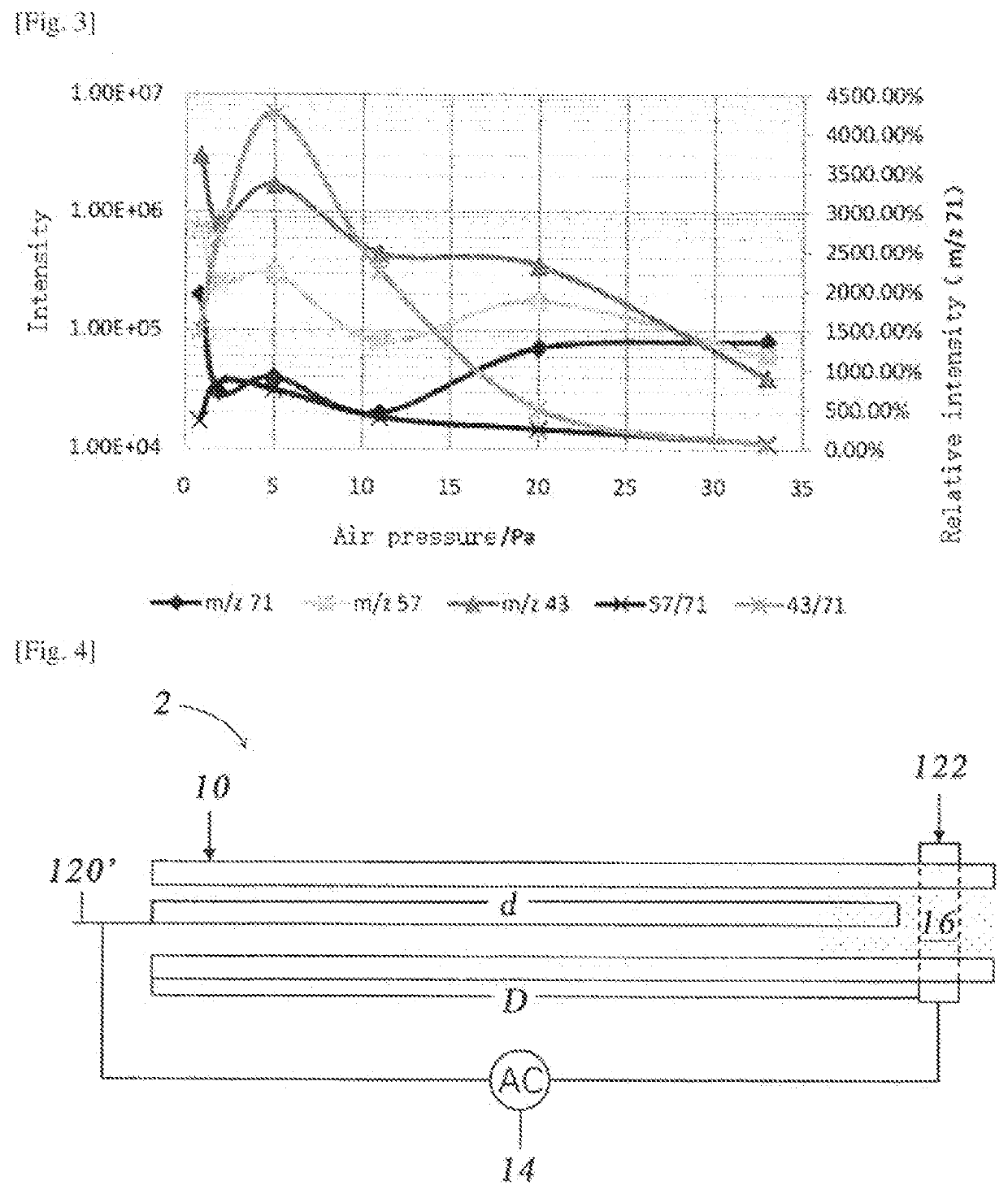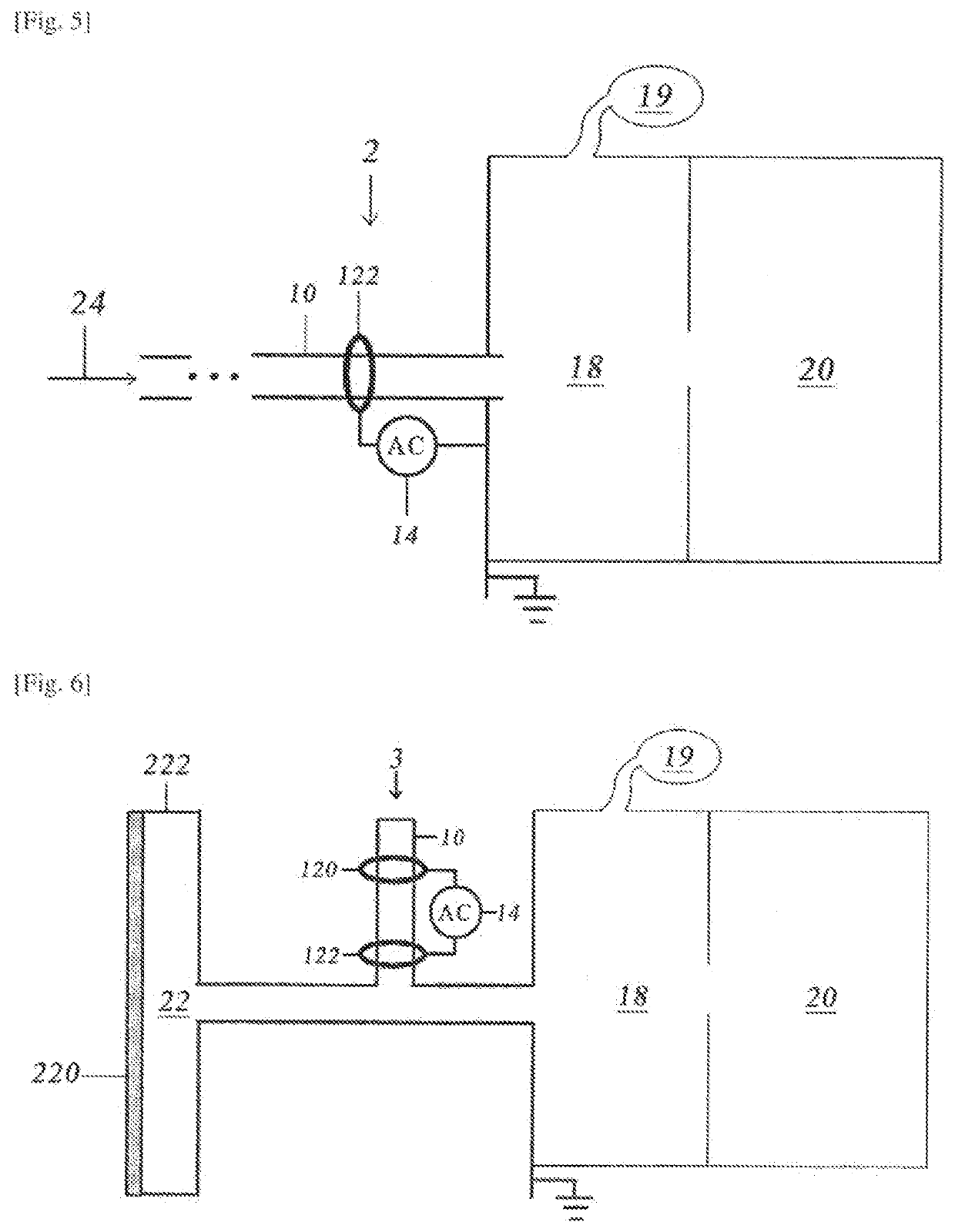Dielectric barrier discharge ionization, analytical instrument and ionization method
a technology of dielectric barrier and discharge ionization, applied in the field of ion analysis devices, can solve the problems of difficult low-pressure work, difficult to ignite common dielectric barrier discharge ionization, and difficult spectrum interpretation, and achieve simple and ingenious design and stable signal
- Summary
- Abstract
- Description
- Claims
- Application Information
AI Technical Summary
Benefits of technology
Problems solved by technology
Method used
Image
Examples
first embodiment
[0052]As shown in FIG. 1, the first embodiment provides dielectric barrier discharge ionization 1. A dielectric barrier discharge tube 10 used by the dielectric barrier discharge ionization is a capillary tube. A pair of annular electrodes 12 (including a first electrode 120 and a second electrode 122) respectively wrap the surface of the outer wall at different positions along the axial direction of the capillary tube, and is arranged coaxially with the dielectric barrier discharge tube 10. An alternating current of 0.2 to 3 MHz can be powered on between the first electrode 120 and the second electrode 122 of the annular electrode 12. The waveform of the alternating current can be a sine wave, a square wave, a sawtooth wave, a step wave, a triangular wave, a pulsedwave or other suitable waveforms. The peak-to-peak amplitude is 100 to 10,000 V. In the present embodiment, the alternating current between the annular electrodes 12 adopts a sinusoidal waveform alternating current of 2.5...
second embodiment
[0067]As shown in FIG. 4, the present embodiment provides an annular dielectric barrier discharge ionization 2, including a dielectric barrier discharge tube 10, an electrode pair consisting of a first electrode 120′ and a second electrode 122, in which an alternating voltage is provided between the first electrode 120′ and the second electrode 122 by an alternating current source 14, and each parameter of the alternating voltage is the same as in the first embodiment. In the embodiment, the dielectric barrier discharge tube 10 is a capillary tube in which the inner diameter is 0.2 mm and the wall thickness is 0.4 mm.
[0068]In the embodiment, the first electrode 120′ is a needle-like electrode with one end thereof extending into the dielectric barrier discharge tube 10, and the extending depth d is smaller than the depth D of the abutting position where the second electrode 122 abuts the dielectric barrier discharge tube 10, that is, the first electrode 120′ cannot reach the abutting...
third embodiment
[0072]The present embodiment provides a mass spectrometer which is relatively similar to that in the first embodiment but have a different sample introduction structure. As shown in FIG. 6, the mass spectrometer uses a sample inlet 22 coated with a semipermeable membrane 220. However, after the sample introduction in the embodiment, instead of directly entering the ionization region of the dielectric barrier discharge ionization 3 to mix with the plasma, the ionized substance outlet of the dielectric barrier discharge tube 10, that is, the lower port of the dielectric barrier discharge tube 10, is provided downstream of the sample inlet 22 along the sample delivery direction, so that the sample can mix with and be ionized by the ionized substance flowing out of the ionized substance outlet.
[0073]In the above manner, the mass spectrometer structure provided by the embodiment can prevent the sample from directly interacting with the electrons in the discharge plasma, which results in ...
PUM
 Login to View More
Login to View More Abstract
Description
Claims
Application Information
 Login to View More
Login to View More - R&D
- Intellectual Property
- Life Sciences
- Materials
- Tech Scout
- Unparalleled Data Quality
- Higher Quality Content
- 60% Fewer Hallucinations
Browse by: Latest US Patents, China's latest patents, Technical Efficacy Thesaurus, Application Domain, Technology Topic, Popular Technical Reports.
© 2025 PatSnap. All rights reserved.Legal|Privacy policy|Modern Slavery Act Transparency Statement|Sitemap|About US| Contact US: help@patsnap.com



